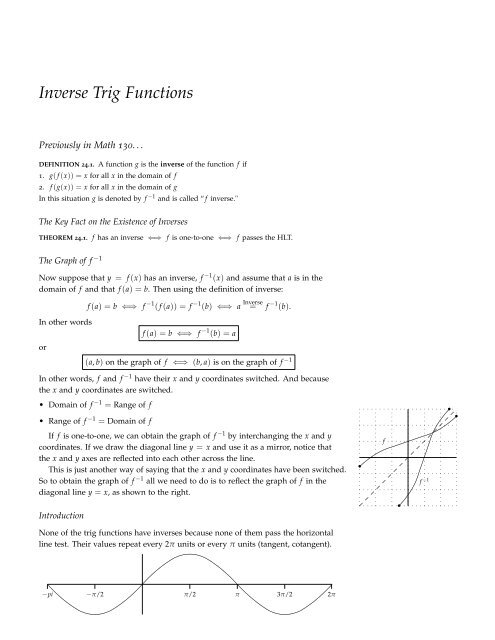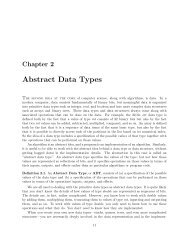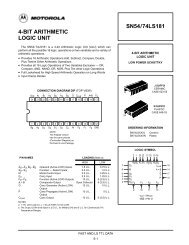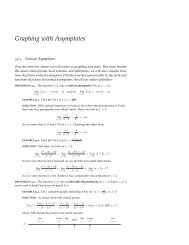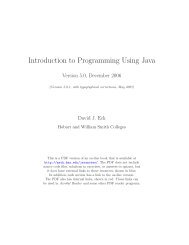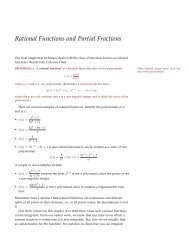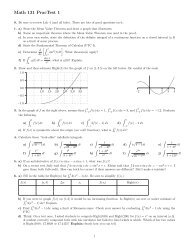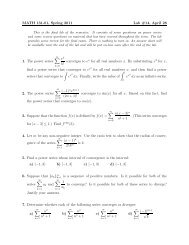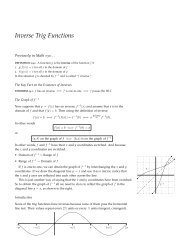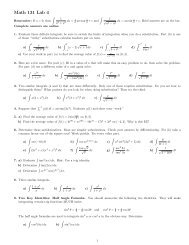Inverse Trig Functions
Inverse Trig Functions
Inverse Trig Functions
Create successful ePaper yourself
Turn your PDF publications into a flip-book with our unique Google optimized e-Paper software.
<strong>Inverse</strong> <strong>Trig</strong> <strong>Functions</strong>Previously in Math 130. . .DEFINITION 24.1. A function g is the inverse of the function f if1. g( f (x)) = x for all x in the domain of f2. f (g(x)) = x for all x in the domain of gIn this situation g is denoted by f −1 and is called “ f inverse."The Key Fact on the Existence of <strong>Inverse</strong>sTHEOREM 24.1. f has an inverse ⇐⇒ f is one-to-one ⇐⇒ f passes the HLT.The Graph of f −1Now suppose that y = f (x) has an inverse, f −1 (x) and assume that a is in thedomain of f and that f (a) = b. Then using the definition of inverse:In other wordsorf (a) = b ⇐⇒ f −1 ( f (a)) = f −1 (b) ⇐⇒ a <strong>Inverse</strong> = f −1 (b).f (a) = b ⇐⇒ f −1 (b) = a(a, b) on the graph of f ⇐⇒ (b, a) is on the graph of f −1In other words, f and f −1 have their x and y coordinates switched. And becausethe x and y coordinates are switched.• Domain of f −1 = Range of f• Range of f −1 = Domain of fIf f is one-to-one, we can obtain the graph of f −1 by interchanging the x and ycoordinates. If we draw the diagonal line y = x and use it as a mirror, notice thatthe x and y axes are reflected into each other across the line.This is just another way of saying that the x and y coordinates have been switched.So to obtain the graph of f −1 all we need to do is to reflect the graph of f in thediagonal line y = x, as shown to the right.Introduction•... •.....f....•...f −1....•None of the trig functions have inverses because none of them pass the horizontalline test. Their values repeat every 2π units or every π units (tangent, cotangent).−pi −π/2 π/2 π 3π/2 2π.
2The <strong>Inverse</strong> Sine FunctionHowever, if we restrict the domain of the sine function (or any of the other trigfunctions) we can make the function one-to-one on the restricted interval. Thefigure on the left below shows sin x restricted to the interval [−π/2, π/2] whereit is, indeed, one-to-one (passes HLT). So it has an inverse there, which we havegraphed in red the figure on the right.1−π/2 π/2−1.−π/2 π/2...................The inverse sine function is denoted by arcsin x. Your text uses sin −1 x, but moststudents find arcsin x less confusing, and that’s what we will generally use in thiscourse. Since the domain and range of the sine and inverse sine functions areinterchanged, we have• the domain of arcsin x is the range of the restricted sin x: [−1, 1].• the range of arcsin x is the domain of the restricted sin x: [−π/2, π/2]. This isvery important. It says that the output of the inverse sine function is a number(an angle) between −π/2 and π/2.Notice since the arcsine function undoes the sine function, we get some familiarvalues: arcsin(−1) = −π/2 since sin(−π/2) = −1. Or arcsin(1/2) = π/6 sincesin(π/6) = 1/2. Or arcsin( √ 3/2) = π/3 since sin(π/3) = √ 3/2.EXAMPLE 24.1. Normally when we calculate f −1 ( f (x)) we get x because the two functionsundo each other. The same is true here, if the domain of sin x is appropriatelyrestricted to [−π/2, π/2]. For example,arcsin(sin(π/4)) = arcsin( √ 2/2) = π/4.But if we take a value outside of the restricted domain [−π/2, π/2] of the sine functionarcsin(sin(3π/4)) = arcsin( √ 2/2) = π/4.Orarcsin(sin(3π)) = arcsin(0) = 0.The two functions do not undo each other since the arcsine function can only returnvalues (or angles) between −π/2 and π/2.The <strong>Inverse</strong> Cosine FunctionWe can restrict the domains of the other trig functions so that they, too, have inverses.The figure on the left below shows cos x restricted to the interval [0, π]where it is, indeed, one-to-one. So it has an inverse there, which we have graphed
math 130, calculus i 3in red the figure on the right.π. π...........11.......−1 1 π−1 1 π...−1.−1.The inverse cosine function is denoted by arccos x. Since the domain and range ofthe cosine and inverse cosine functions are interchanged, we have• the domain of arccos x is the range of the restricted cos x: [−1, 1].• the range of arccos x is the domain of the restricted cos x: [0, π].EXAMPLE 24.2. Again we have to be careful about calculating the composites of theseinverse functions. They are only inverses when the inputs are in the correct domains.For example,arccos(cos(π/4)) = arccos( √ 2/2) = π/4.But if we take a value outside of the restricted domain [0, π] of the cosine functionOrarccos(cos(−π/4)) = arccos( √ 2/2) = π/4.arccos(cos(3π)) = arccos(−1) = π.The two functions do not always undo each other since the inverse cosine function canonly return values between 0 and π.The <strong>Inverse</strong> Tangent FunctionThe figure on the left below shows tan x restricted to the interval (−π/2, π/2)where it is, indeed, one-to-one. So it has an inverse there, which we have graphedin red the figure on the right.−π/2 π/2........π/2.........−π/2 . π/2.....−π/2......The inverse tangent function is denoted by arctan x. Since the domain and range ofthe tangent and inverse tangent functions are interchanged, we have• the domain of arctan x is the range of the restricted tan x: (−∞, ∞).
4• the range of arctan x is the domain of the restricted tan x: (−π/2, π/2).EXAMPLE 24.3. Again we have to be careful about calculating the composites of theseinverse functions. They are only inverses when the inputs are in the correct domains.For example,arctan(tan(π/4)) = arctan(1) = π/4.But if we take a value outside of the restricted domain (−π/2, π/2) of the tangentfunctionarctan(tan(3π/4)) = arctan(−1) = −π/4.Orarctan(tan(3π)) = arctan(0) = 0.The two functions do not always undo each other since the inverse tangent functioncan only return values between −π/2 and π/2.We will concentrate only on the the three inverse functions discussed above. Iwill leave it to you to read about the other inverse trig functions in your text.Evaluation Using TrianglesDrawing appropriate right triangles can help evaluate complicated expressionsinvolving the inverse trig functions.EXAMPLE 24.4. Evaluate cos(arcsin x).SOLUTION. Remember that arcsin x = θ where θ is just the angle whose sine is x. Wewant the cosine of this same angle. So let’s draw a right triangle with angle θ whosesine is x. Since the sine function is opphyp we can use the triangle below.1xθ.x 2 + y 2 = 1 ⇒ y = √ 1 − x 2 .yNotice sin θ =1 x = x. So arcsin x = θ. (θ is the angle whose sine is x.) Socos(arcsin x) = cos(θ) = y √1 − x1 = 2= √ 1 − x12 .EXAMPLE 24.5. Evaluate sec(arctan x).SOLUTION. This time we draw a triangle whose tangent is x.zxSo.θ1z 2 = 1 2 + x 2 ⇒ z = √ 1 + x 2 .sec(arctan x) = sec(θ) = z 1 = √ 1 + x 2 .EXAMPLE 24.6. Evaluate sin(arccos 2/5).SOLUTION. This time we draw a triangle whose cosine is 2/5.5xSo.θ22 2 + x 2 = 5 2 ⇒ x = √ 5 2 − 2 2 = √ 21.sin(arccos 2/5) = sin(θ) = x 5 = √215 .YOU TRY IT 24.1. Evaluate sin(arctan x) and cos(arcsin 3/4)).
math 130, calculus i 5Derivatives of arcsin x and arctan xSurprisingly, it is relatively easy to determine the derivatives of the inverse trigfunctions, assuming that they are differentiable. We will use implicit differentiation(really just the chain rule in disguise) just as we did when we figured out thederivative of ln x.Let’s first determine the derivative of y = arcsin x for − π 2 ≤ x ≤ π 2. We want tofind dydx. First apply the inverse:y= arcsin xsin(y) = sin(arcsin x) = x.Now take the derivative using implicit differentiation on the left:D x [sin(y)] = D x [x]cos(y) dydx = 1Solve for dydx .dydx = 1cos(y) = 1cos(arcsin x)But in Example 24.4 we found that cos(arcsin x) = √ 1 − x 2 so we haveThat isdydx = 1cos(arcsin x) = 1√ .1 − x 2ddx (arcsin x) = 1√1 − x 2 .The derivative of y = arctan x for − π 2< x < π 2is determined in a similarfashion. We want to find dydx. First apply the inverse:y = arctan xtan(y) = tan(arctan x) = x.Now take the derivative using implicit differentiation on the left:D x [tan(y)] = D x [x]sec 2 (y) dydx = 1Solve for dydx .dydx = 1sec 2 (y) = 1sec 2 (arctan x)But in Example 24.5 we found that sec(arctan x) = √ 1 + x 2 so we have sec 2 (arctan x) =1 + x 2 . Thereforedydx = 1sec 2 (arctan x) = 11 + x 2 .That isd1(arctan x) =dx 1 + x 2 .YOU TRY IT 24.2 (Extra Credit). Determine the formula for the derivative of arccos x using themethod above. Show your work.Keep going and find the derivatives of the remaining three inverse trig functions. Againshow your work.
6Chain Rule VersionsThe chain rule versions of both derivative formulas are:ddx (arcsin u) = 1 du√1 − u 2 dxd1 du(arctan u) =dx 1 + u 2 dxEXAMPLE 24.7. Let’s use these formulas to find the derivatives of the following:ddx (arctan 1e3x ) =1 + (e 3x ) 2 · 3e3x = 3e3x1 + e 6x . (u = e3x )ddx (arcsin 3x2 ) =1√1 − (3x 2 ) 2 · 6x =6x√1 − 9x 4 . (u = 3x2 )ddx (earctan 3x ) = e arctan 3x 1 3earctan3x· 3 =1 + 9x2 1 + 9x 2 .ddx (sin 2x arctan 5x2 ) = 2 cos 2x arctan 5x 2 + sin 2x ·= 2 cos 2x arctan 5x 2 +10x sin 2x1 + 25x 4 .11 + 25x 4 · 10xddx (ln | arcsin 3x|) = 1arcsin 3x · 1√ · 3 = 31 − 9x 2 (arcsin 3x) √ 1 − 9x . 2D x (| arcsin(ln 3x)) =1√ · 11 − [ln(3x)] 2 3x · 3 = 1x √ 1 − [ln(3x)] . 2(u = ln(3x))YOU TRY IT 24.3. Find the derivatives of these functions:(a)dddx arctan(6x2 )] (b)dx [arcsin(√ x)](e)ddx [arctan(ln |6x|)] (f ) ddx [arcsin(6esin x )](i)ddx (ln | arctan +1 ex4 |)The answers are on the next page.(c)ddx [arctan(e2x ](g)ddx (e2 arcsin x2 )(d)d[arcsin(arcsin x)]dx(h)ddx [(arcsin 2x)(tan 5x2 )]
math 130, calculus i 7Answers.1. Answers to you try it 24.3 .(a)d112xdx (arctan(6x2 )) = · 12x =1 + 36x4 1 + 36x 4(b)ddx (arcsin(√ 1x)) = √ · 11 − x 2 · 1x−1/2 =2 √ x √ 1 − x(c)(d)(e)(f )(g)(h)(i)ddx (arctan(e2x )) =2e2x1 + e 4xddx (arcsin(arcsin x)) = 1√ · 1√1 − (arcsin x) 2 1 − x 2ddx [arctan(ln |6x|)] = 11 + (ln |6x|) 2 · 16x · 6 = 1x[1 + (ln |6x|) 2 ]ddx (arcsin(6esin x )) =1√1 − (6e sin x ) 2 · (6esin x )(cos x) =ddx (e2 arcsin x2 ) = (e 2 arcsin 1x2 4xe2arcsin x2) · 2 · √ · 2x = √1 − (x 2 ) 2 1 − x 4ddx [arcsin 2x(tan 5x2 )] =ddx (ln | arctan ex4 +1 |) =2 tan 5x2√1 − 4x 2 + (arcsin 2x)10x sec2 (5x 2 )1arctan e x4 +1 ·6 cos xesinx√1 − (6e sin x ) 211 + (e x4 +1 ) 2 · ex4 +1 · 4x 3 =4x 3 e x4 +1(arctan e x4 +1 )(1 + e 2x4 +2 )


